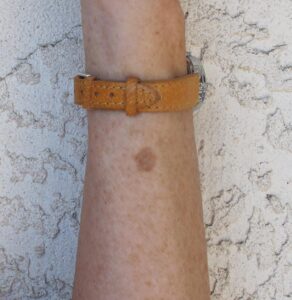Age spots are commonly found on adults, aged 50 or older, with a light complexion. They appear as flat, small, dark areas on your skin. They come in different shapes, sizes, and colors. However, they usually:
- Are a close variation of an oval shape.
- Are tan, black, or brown in color.
- Range from the size of a small freckle to the size of a U.S dime. They may cluster together as well, making them easier to notice.

Example of an age spot located on the wrist
Should I see a doctor?
Whenever something new appears on your skin, a major alarm may sound off in your head. Nowadays, with the sun’s harmful effects at the forefront of attention more than ever, you have every reason to be concerned. The good news is that while they look cancerous, true age spots are completely harmless and cannot lead to skin cancer.
Age spots do not require medical attention unless they aren’t actually age spots. You can tell the difference by asking yourself these questions:
- Is the spot abnormally dark or comprised of a combination of colors?
- Is the spot larger than a dime and/or quickly increasing in size?
- Do you suffer from itching, bleeding, tenderness, or redness surrounding the spot?
- Is the spot irregularly shaped (Not resembling an oval)?
If you can answer “yes” to any of these questions, contact your primary care physician right away.
So why should I treat them?
While age spots don’t cause any medical concern, they may register as a cosmetic concern. You may wish to remove them in order to improve your appearance, self-confidence, or overall skin health.
How do age spots form?
Solar Lentigo, the scientific name for age or liver spots, form due to a multitude of reasons. The main one being overexposure to the sun. That’s why you’re most likely to see these blotches of dark skin on areas of your body that are constantly being exposed to the sun. Areas such as: your face, shoulders, forearms, and the back of your hands count in among the favorite hang out spots for your solar lentigos.
Some people are also genetically predisposed to age spots. This can lead to age spots developing at a much earlier age than usual. We often see the same thing with other skin blemishes, like freckles.
Besides genetics and overexposure to sunlight, aging of the skin and exposure to alternate forms of UV light are also a factor in the development of age spots. Since they are a result of excess melanin production. UV lights (which accelerate melanin growth), such as the ones in tanning beds, can also be considered a cause of age spots.
How do I get rid of my age spots?
There are several methods to consider when trying to rid yourself of age spots. If you are just looking to conceal them, or lighten them slowly over time, many over-counter fade creams and lotions made specifically for age spots exist. These can be found on the internet or at your local drugstore.
Active ingredients that can improve pigmentation spots include: hydroquinone, glycolic acid, deoxyarbutin, kojic acid, or alpha hydroxy acid. Hydroquinone can have side effects including skin irritation or darkening of the skin if overused. We don’t recommend using this ingredient for more than 3 months in a row and it is best used under the guidance of a doctor. If you are looking for something stronger, we suggest speaking to your doctor in order to obtain a prescription strength skin lightening cream.
If you are looking to completely remove your age spots, undergoing some sort of medical procedure may be necessary. There are 4 main procedure options when it comes to a complate removal.
- Laser Therapy and Light Therapy: Widely regarded as the quickest way to remove age spots completely, laser therapy may eradicate your lentigo in just one or two sessions, while bringing long-lasting results. Here at The Aesthetics Center, we offer two types of treatments when tasked with removing age spots:
- Intense pulsed light treatment, or IPL treatment, discharges multiple wavelengths of light at your skin. There is little to no downtime and one session takes less than 40 minutes to complete.
- Laser skin resurfacing removes your skin layer by layer. In turn, new younger skin cells grow back to replace the old destroyed ones.
- Cryotherapy: This procedure involves a dermatologist freezing the age spots in a controlled manner. The session may be painful, but it is over quickly. As the treated area heals over time, you will notice that your skin is lighter.
- Chemical Peeling: This removes the outer layer of skin. It involves applying an acid to the affected area of your skin. It may take several treatment sessions in order to achieve results.
- Microdermabrasion: In this procedure, a physician uses an extremely sharp and precise blade to gently remove the top layer of skin. This smooths the skin and, over several treatment sessions, can remove skin blemishes. This method generally works better when combined with another procedure, such as a chemical peel.
How can I prevent age spots from reappearing after treatment?
Age spots may not be completely preventable, but there are certain things you can do to mitigate future production of them.
- Wear sunscreen every single day. Try to reapply every two hours, and more frequently if swimming or sweating. Look for an SPF factor of at least 30 for optimum sun protection. For more on sun protection, click here.
- If possible, stay out of direct sunlight from 10:00 a.m. to 2:00 p.m. This is when the sun is most intense and most likely to speed up production of age spots.
- Wear clothing that provides protection from the sun. Clothing that is designed specifically for sun protection exists. Look for sun protective clothing online or in stores near you that carry an ultraviolet protection factor (UPF) of at least 40.
